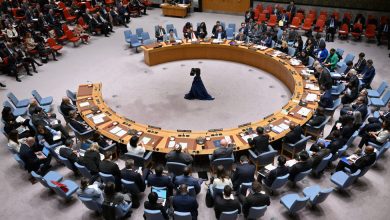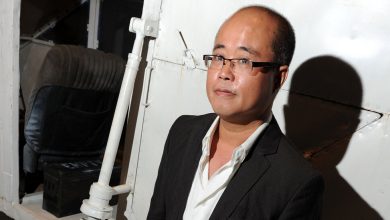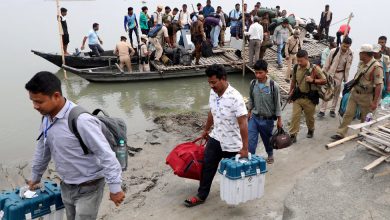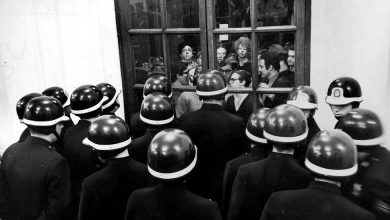He’s Australia’s Most Decorated Soldier. Did He Also Kill Helpless Afghans?

MELBOURNE, Australia — The elite Australian troops stormed into a mud-walled Afghan village in the late summer of 2012 on a white-hot mission.
Days earlier, a rogue Afghan Army soldier had killed three of their comrades. A tip indicated that the assailant might be hiding in the village. While a search failed to turn him up, the Australian special forces fatally shot another Afghan man they encountered there.
That much is known. But the moments just before the man’s death have become the subject of an intense legal dispute involving Australia’s most decorated living soldier, rekindling hard questions about the costs of the country’s 20-year mission in Afghanistan and the conduct of its most highly trained soldiers.
In one version of events, the dead man was a laborer named Ali Jan, and he was kicked off a cliff by the decorated soldier, Ben Roberts-Smith. According to this account, Mr. Jan, bound in handcuffs, hit the ground with such force that his teeth were knocked out, and he was then shot dead as Mr. Roberts-Smith watched. This is the story told by three Australian journalists who wrote about the episode and by three Afghan men who say they were at the scene.
In the other version, told by Mr. Roberts-Smith, there was no cliff and no kick, and little evidence that the man was even called Ali Jan. The special forces, Mr. Roberts-Smith said, legitimately engaged and killed the man, who was a Taliban scout.
The two accounts have emerged as Mr. Roberts-Smith, 42, sues three newspapers for defamation in what has been called Australia’s trial of the century. He is seeking the largest damages award in Australian history, most likely in the millions of dollars.
Australia removed the last of its troops from Afghanistan in June, weeks before the United States did the same, allowing a rapid takeover of the country by the Taliban. Seven months earlier, the Australian military had released a damning public accounting of years of battlefield misconduct among its special forces in Afghanistan, including “credible evidence” that 25 soldiers had been involved in the murders of 39 Afghan civilians.
No soldiers were named in the report. But it has been revealed in court that Mr. Roberts-Smith, and the events of the late-summer day in 2012, are under police investigation over potential war crimes. With further investigation into battlefield misconduct likely to take years to resolve, the defamation case is the first time any inquiry into soldiers’ actions in Afghanistan has played out in open court.
Mr. Roberts-Smith is a symbol of the “Anzac myth,” a belief that modern-day Australia was forged by soldiers, stretching back to World War I, who embodied the national values of camaraderie, courage and sacrifice, said John Blaxland, a national security expert and war historian at the Australian National University. “And this case is exposing the weak foundations of the myth,” he said.
Courtroom Showdown
Ben Roberts-Smith’s path to the battlefields of Afghanistan was set at an early age.
He was educated at a prestigious private boys’ school in Western Australia that has spawned politicians and mining magnates. Following in the footsteps of his father, a retired army major general and state Supreme Court justice, he joined the military at 18.
He went on to become the only current member to receive the military’s two top honors. He was awarded the Medal of Gallantry in 2006 and the Victoria Cross in 2011, both for actions in Afghanistan.
In 2013, the year he left the full-time army, he was named Australia’s Father of the Year. Two portraits of him are displayed in the nation’s war memorial, as is a uniform he wore in Afghanistan, for which the memorial had to make a special mannequin because Mr. Roberts-Smith stands about 6 feet 8 inches tall.
“Wherever he went, wherever it was, he was the subject and object of what I would regard as reverential mobs,” Brendan Nelson, a former defense minister who once led the war memorial, said during the defamation trial.
That changed in 2018, after The Age, a Melbourne newspaper, and its sister newspapers The Sydney Morning Herald and The Canberra Timespublished a series of articles reporting that a powerful and charismatic senior officer had killed or been involved in the murder of Afghan detainees.
Mr. Roberts-Smith was not named in the articles, but he later asserted that he was clearly identifiable. Soon after their publication, he began defamation proceedings against the newspapers.
The papers, which under Australian law have the onus of proving that what they reported was substantially true, have said in court that Mr. Roberts-Smith was involved in six killings, none of which occurred “in the heat of battle.”
But over nearly two weeks of testimony in June, Mr. Roberts-Smith strenuously denied the allegations, saying that five of the deaths occurred during combat and that the sixth never happened.
In a packed Sydney courtroom, he painted a noble image of special forces soldiers. “I did everything that I was supposed to do, and I followed the rules,” he said.
His virtuous portrayal sometimes clashed with bizarre and lurid details that emerged during the trial. Mr. Roberts-Smith admitted hiring a private investigator to spy on a girlfriend at an abortion clinic after they had agreed to end her pregnancy. He told the court that soldiers had used the prosthetic leg of an Afghan he had killed — an armed Taliban insurgent in his telling, and a prisoner in the journalists’ — as a drinking vessel.
As for the centerpiece allegation — that he kicked an Afghan man off a cliff and witnessed his murder — Mr. Roberts-Smith said, “Frankly, I can’t see how they can believe it, because none of it adds up.”
Three Afghan witnesses, testifying through an interpreter via video from Kabul, told a very different story. They said that they had known Mr. Jan as a laborer who had no Taliban connections. Two said they had seen a “big soldier” kick him off a cliff and later found Mr. Jan’s body with bullet wounds.
Mohammed Hanifa, who said he was Mr. Jan’s step-nephew, testified that he had been detained alongside Mr. Jan. Both had their hands tied behind their backs, he said.
“I told Ali Jan, don’t laugh or don’t smile, because they do not like when you smile or when you laugh,” he said.
Understand the Taliban Takeover in Afghanistan
Who are the Taliban? The Taliban arose in 1994 amid the turmoil that came after the withdrawal of Soviet forces from Afghanistan in 1989. They used brutal public punishments, including floggings, amputations and mass executions, to enforce their rules. Here’s more on their origin story and their record as rulers.
Who are the Taliban leaders? These are the top leaders of the Taliban, men who have spent years on the run, in hiding, in jail and dodging American drones. Little is known about them or how they plan to govern, including whether they will be as tolerant as they claim to be. One spokesman told The Times that the group wanted to forget its past, but that there would be some restrictions.
How did the Taliban gain control? See how the Taliban retook power in Afghanistan in a few months, and read about how their strategy enabled them to do so.
What happens to the women of Afghanistan? The last time the Taliban were in power, they barred women and girls from taking most jobs or going to school. Afghan women have made many gains since the Taliban were toppled, but now they fear that ground may be lost. Taliban officials are trying to reassure women that things will be different, but there are signs that, at least in some areas, they have begun to reimpose the old order.
What does their victory mean for terrorist groups? The United States invaded Afghanistan 20 years ago in response to terrorism, and many worry that Al Qaeda and other radical groups will again find safe haven there. On Aug. 26, deadly explosions outside Afghanistan’s main airport claimed by the Islamic State demonstrated that terrorists remain a threat.
How will this affect future U.S. policy in the region? Washington and the Taliban may spend years pulled between cooperation and conflict, Some of the key issues at hand include: how to cooperate against a mutual enemy, the Islamic State branch in the region, known as ISIS-K, and whether the U.S. should release $9.4 billion in Afghan government currency reserves that are frozen in the country.
But then the big soldier came, Mr. Hanifa said, and Mr. Jan smiled. The soldier “kicked him really hard,” and Mr. Jan “was rolling down, rolling down until he reached the river. The soldier was looking at him. He was standing and looking at him.”
Shortly after the Afghan men testified in late July, the proceedings were delayed until November because of a coronavirus outbreak in Sydney. The trial is expected to run well into next year.
Pursuing Justice
When the Australian military released its report on battlefield misconduct in November, the country was commended for its openness and transparency. The military vowed sweeping changes, and 19 soldiers were referred for criminal investigation.
The government set up an independent office to investigate the cases and provided it with funding and experienced officials.
But it is unlikely that all the soldiers will go to trial, given the increasing challenge of collecting evidence about events that happened over a decade ago, said Ben Saul, who teaches international law at the University of Sydney.
“The longer this drags on,” he said, “the more difficult it is to get a successful prosecution.”
And the more time that passes, the more the investigations may be susceptible to domestic forces. With the accused soldiers garnering significant public support, Professor Saul said, “the question is whether that support over time tips over into pressure to basically stop these kinds of investigations or prosecutions.”
There are already signs of a shifting political agenda. When a new defense minister, Peter Dutton, took office in April, one of his first acts was to reverse a decision to strip a meritorious unit citation from a group of about 3,000 special forces soldiers at the center of the misconduct report. Mr. Dutton said he wanted to let soldiers know that “the government had their back.”
The defense minister is trying to “minimize further fallout,” said Professor Blaxland, the national security expert, and prevent any further damage to the special forces as Australia turns its attention toward the prospect of great-power conflict in Asia.
The government, Professor Blaxland added, also wants to shield itself from questions about its leadership during the Afghanistan war, especially as defenders of the military argue that the soldiers were just following its orders.
The case of Mr. Roberts-Smith strikes at the heart of the debate, he said: “Was this something that Australian soldiers were doing legitimately, did the Australian government support it happening, and did the Australian government enable it to happen?”




